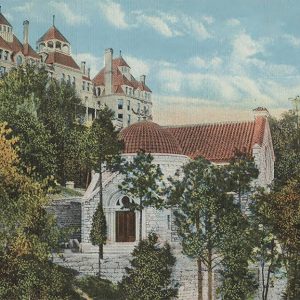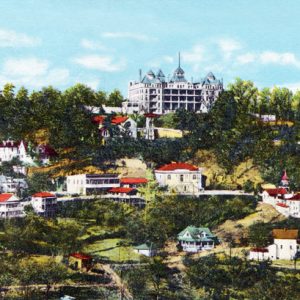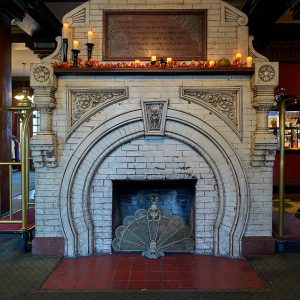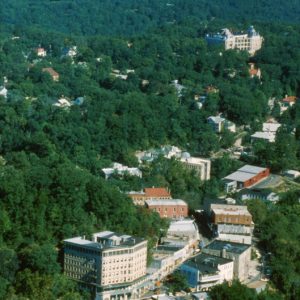calsfoundation@cals.org
Crescent Hotel
The Crescent Hotel was built in 1886 in Eureka Springs (Carroll County) by the Eureka Improvement Company, the president of which was former governor Powell Clayton. The organization purchased twenty-seven acres of wooded land for the site of the hotel and hired Isaac S. Taylor from St. Louis, Missouri, as architect for the project. The massive eighteen-inch-thick stones used for the body of the hotel were made of limestone, hand-carved from a quarry on the White River near Beaver (Carroll County) by a crew of Irish workers. These stones were hauled to the site of the hotel by trains and specially constructed wagons, and were placed in such a fashion that no mortar was needed.
The hotel boasted every modern convenience, from electricity to elevators, and was well known for its location near the springs that supposedly held healing waters. The cost for this hotel, declared America’s most opulent resort, was $294,000. The hotel opened its doors to the public on May 1, 1886, with an open house two weeks later. On May 20, a banquet was held for guest of honor James G. Blaine, the 1884 Republican presidential nominee. A gala ball was held for the 400 attendants, with Harry Barton’s orchestra entertaining, followed by a speech from Blaine.
The Crescent enjoyed great success for many years, but as the economy worsened in the 1900s, the hotel opened for business only during the summer months. The Eureka Springs Investment Company formulated a plan to use the facility year-round and, in 1908, opened the hotel as an elite girls’ boarding school called Crescent College and Conservatory for Young Women. The college operated from September through June, converting into a hotel during the summer months. The college remained open for sixteen years but was forced to close its doors in 1924 due to lack of funding. It was reopened in 1929 and remained open until 1933.
In 1925, the Crescent was sold, and its new owners advertised the hotel for its exquisite cuisine and special weekly rates. By 1929, the hotel had changed hands again and was only open seasonally. Business was further slowed by the onset of the Depression, and the Crescent closed its doors in 1933. In 1937, the hotel was purchased by Norman Baker, who opened the Baker Hospital and Health Resort in 1938 to serve cancer patients. The lobby of the hotel was remodeled and painted bright purple and featured large geometric designs, which reflected the character and wardrobe of its owner. This venture, however, was short lived; Baker was convicted of mail fraud in 1940, and the hospital closed. The Crescent fell into disrepair for six years, and not until 1946 was the property purchased again and renovated to its original look, reopening on July 4, 1946, as “A Castle in the Air High Atop the Ozarks.”
The hotel has enjoyed a long period of success, despite a fire on the fourth floor in 1967, which damaged some of the building. In 1973, restorations began, and the hotel was again open to the public by May of that year. Renovations came again in 1980 to restore the original luxury to the hotel. On February 28, 1997, Marty and Elise Roenigk purchased the hotel and renovated it extensively, returning the roofline to its original appearance and adding historically themed furnishings. In addition, the couple added the New Moon Spa to the basement level, reflecting the original purpose of the hotel as a destination for relaxation and healing. The Crescent is also a member of the National Trust Historic Hotels of America and has been featured on the Discovery Channel for its historic Victorian beauty and many reported ghost sightings. The hotel was added to the National Register of Historic Places on January 26, 2016. In November 2022, Elise Roenigk received the Lifetime Achievement Award for her role in preserving the Crescent from the Historic Hotels of America.
On February 5, 2019, an excavation for the purposes of expanding a parking area uncovered a wealth of bottles corresponding to various “cures” and medicine bottles once owned by Norman Baker but reportedly discarded in the 1960s.
For additional information:
Bowden, Bill. “Glass Bottles Date to ’38 Cancer Elixir.” Arkansas Democrat-Gazette, April 12, 2019, pp. 1A, 5A. Online at https://www.arkansasonline.com/news/2019/apr/12/glass-bottles-date-to-38-cancer-elixir-/ (accessed January 4, 2023).
Crescent Hotel. http://www.crescent-hotel.com/ (accessed March 14, 2022).
“Crescent Hotel.” National Register of Historic Places nomination form. On file at Arkansas Historic Preservation Program, Little Rock, Arkansas. Online at http://www.arkansaspreservation.com/National-Register-Listings/PDF/CR0679_nr.pdf (accessed March 14, 2022).
DenHoed, Andrea. “The Haunting History of a Huckster’s ‘Cancer Cure.’” New Yorker, April 26, 2022. https://www.newyorker.com/culture/photo-booth/the-haunting-history-of-a-hucksters-cancer-cure (accessed April 27, 2022).
Fitzgibbon, Sean. What Follows Is True: Crescent Hotel. Fayetteville, AR: Curio Box Publishing, 2021.
John-Cole, Joada. “Crescent College and Conservatory of Music.” Carroll County Historical Quarterly 27 (Spring 1982): 1–10.
Nelson, Rex. “Honoring a Visionary.” Arkansas Democrat-Gazette, January 4, 2023, p. 7B. Online at https://www.arkansasonline.com/news/2023/jan/04/honoring-a-visionary/ (accessed January 4, 2023).
Jenny Vego
Shiloh Museum of Ozark History













Comments
No comments on this entry yet.